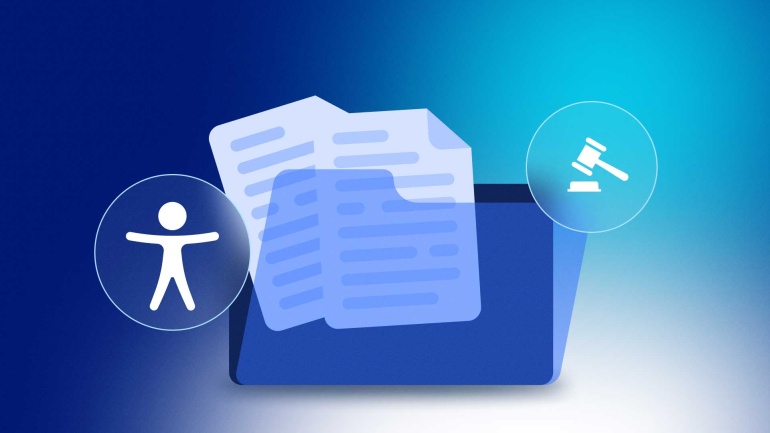Creating a diverse, equitable, and inclusive (DEI) work environment has become a huge motivator for many organizations. This is in response to a heightened awareness of long-overlooked deficiencies and the desire to offer employees a workplace that reflects their values. A vital component of DEI is workplace accessibility.
When workplaces are accessible, they are inclusive and accommodating to people with disabilities. This includes having a physical workplace that is built and maintained to accommodate workers with disabilities, allowing them to access facilities and perform their jobs. In today’s workplaces, accessibility should also include maintaining certain digital standards for workplace intranets, software, and websites.
The Rising Importance of Workplace Accessibility
The prevalent need for online workplace accessibility has been highlighted in recent years. The problem puts companies at risk of losing talent and even facing legal penalties.
The pandemic-related shift to remote and online-based work is one factor. When offices were forced to close, companies quickly discovered their digital work structure did not adequately support workers with visual, auditory, cognitive, and motor impairments. These problems created friction with workflows and limited people from what they could accomplish from home.
A surge in website-related lawsuits over the past five years under the Americans with Disabilities Act (ADA) and the U.S. Rehabilitation Act has also caught the attention of decision-makers. Some of these lawsuits include employee plaintiffs suing current or former employers for allegedly failing to provide work-related software that is compliant with Web Content Accessibility Guidelines (WCAG).
Ways to Improve & Promote Digital Accessibility in the Workplace
Improving digital workplace accessibility cannot be done overnight or by delegating it to an IT department. It’s simply too large and foundational of a problem to be successfully managed by a few people.
Due to factors like future updates and new content, a successful website and intranet accessibility initiative will ultimately require a company-wide, top-down shift in attitude regarding accessibility in the workplace.
IT departments will be the best equipped for implementation and technical support. However, long-term and meaningful success in digital accessibility will take support from product, design, and marketing teams.
Let’s explore some actionable steps companies can make in this direction.
Have a C-Suite Executive Sponsor Workplace Accessibility
Assigning an executive to specifically support and promote accessibility in the workplace is a straightforward and immediate step companies can make.
Placing a figurehead over an accessibility initiative not only communicates a commitment to your workforce but also provides the needed energy, vision, and resource access needed to accomplish goals.
Set Specific Goals for Disabilities in the Workplace
Communicating vision and timelines for the inclusion of disabilities in the workplace is another powerful first step.
A vision and timeline for workplace accessibility expresses expectations and allows for accountability. These goals can include which areas of an organization will be addressed and which regulatory compliance goals an organization will strive for (WCAG 2.0, WCAG 2.1, or even WCAG 3.0).
Establishing this vision is also an opportunity to identify specific workplace training your organization will strive for and any programs it wants to incorporate for employees.
Identify Biases & Barriers to Disabilities in the Workplace
Commissioning an accessibility audit from a third-party agency on your company’s brick-and-mortar workspaces and digital assets is a great short-term goal to promote inclusion. It’s also wise in order to assess potential liabilities for equal employment violations.
Basic digital accessibility audits can be done through automated scanning tools for little to no cost and can help discover and identify flagrant WCAG violations. These results are great ways for preliminary assessments of a website; however, they’re susceptible to false flags and negatives.
For more in-depth analysis, a manual audit can be conducted by an expert accessibility software team. Employing people from the disabled community for user experience and product testing is also an essential way to identify barriers.
These audits will help show your company where there are current successes in your accessible workplace infrastructure and where there are opportunities. Conducting these audits will likely provide valuable information for future planning and goal setting.
Accommodate Off & Online Assistive Tools for Workplace Accessibility
Once barriers are identified, plans should be made to make necessary changes to accommodate assistive tools and assistive technology for employees. For example, offering robust wheelchair accessibility, Braille alternative documents, and English Sign Language (ESL) translation for all corporate events.
Assistive technology, such as screen readers and Braille displays, should also be supported on all intranets, employee portals, and company websites. Alternative input methods should also be supported, including keyboard-only navigation, speech dictation, and switch control.
Advocating for digital accessibility while failing to support in-house assistive needs for employees with disabilities can be detrimental to an accessibility project and discourage teams.
Implement Disability Awareness Workplace Accessibility Training
Some workers may have little or no experience working with someone with a disability. Others may not understand why accommodations matter at all. Implementing a companywide training regiment for disability awareness can help bring exposure and more understanding.
When there is no experience or empathy, people can be inconsiderate of accessibility accommodations. Inexperience can also lead people to try to be overwhelmingly helpful and insulting.
Training and interacting with someone with a disability can help bring understanding to how to talk about disabilities and how to respectfully interact with this community.
Launch a Designated Employee Resource Group (ERG) for Disabilities in the Workplace
Listening is a powerful tool for disability awareness for employees. Listening also helps to track what others are saying about your company.
One way to make space for these listening opportunities is to launch an Employee Resource Group (ERG) or an empathy lab for employees.
These groups provide front-line insights into the state of accessibility in a company and what violations may exist. Support groups like these are also great touchpoints for people to feel confident their concerns are raised.
Accommodating Disabilities in a Workplace
Web accessibility is an important facet of DEI that can make or break someone’s user experience. However, digital accessibility is a significant undertaking for corporations and requires buy-in from various departments and leadership. One of the best ways companies can promote accessibility overall is by making workplace accessibility a priority to reflect their commitments to inclusion and diversity.



